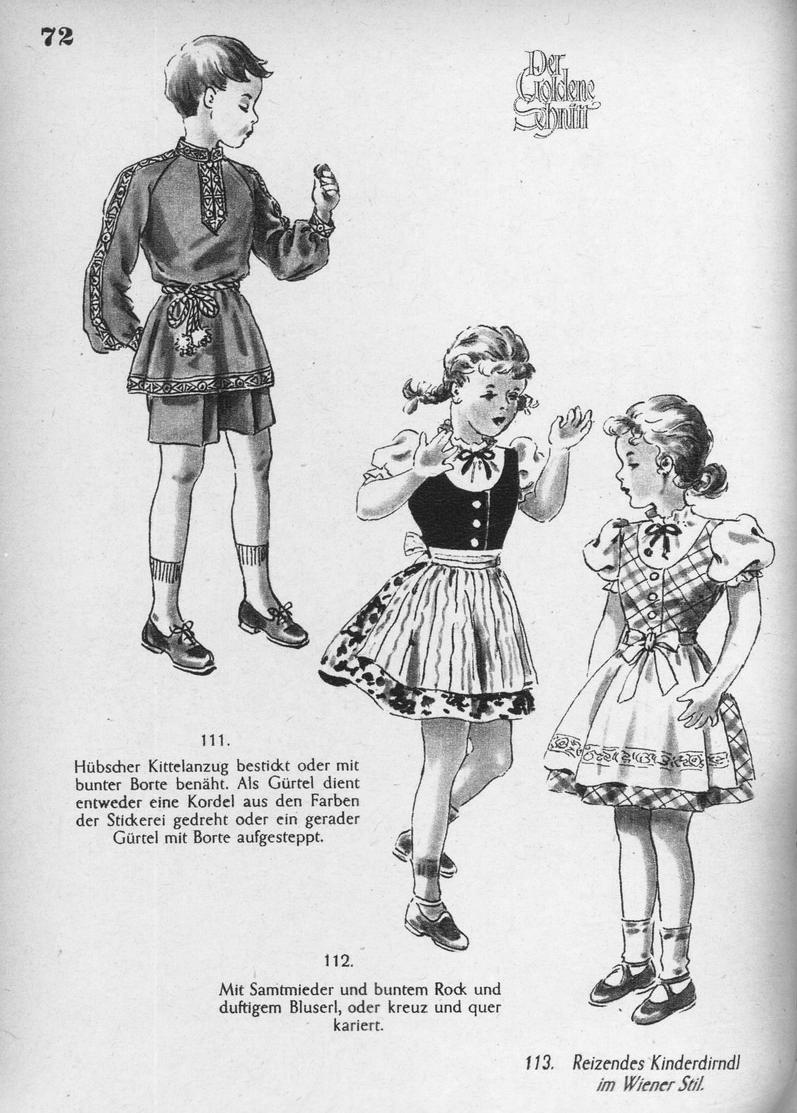
German Mail Order Catalog; Der Goldene Schnitt-- Traditional Outfits (1950s)

Figure 1.-- Der Golden Schnitt appears to be a German mail order company, but other than a few pages from one of their catalogs, we have been able to find nothing about them. The name comes from a classic mathmatical princiole known as the Golden Ratio forst notice by classical scholars. We are not sure why this was name was chosen, excep as it may give the impression of classic styles and high quality. One page provides two classic styles for one boys, the peasant blouse or tunic and the gir;'s peaant dress or Durndl. The lages are not dates. The styles are more in keeping with the 1930s, although the pages have more the look of the 1950s.
|
|
Der Golden Schnitt appears to be a German mail order company, but other than a few pages from one of their catalogs, we have been able to find nothing about them. The name comes from a classic mathmatical princiole known as the Golden Ratio forst notice by classical scholars. We are not sure why this was name was chosen, excep as it may give the impression of classic styles and high quality. One page provides two classic styles for one boys, the peasant blouse or tunic and the gir;'s peaant dress or Durndl. The lages are not dates. The styles are more in keeping with the 1930s, although the pages have more the look of the 1950s. Hopefully our German readers can provide some insights here.
Goldene Schnitt
Der Golden Schnitt appears to be a German mail order company, but other than a few pages from one of their catalogs, we have been able to find nothing about them. The name comes from a classic mathmatical princiole known as the Golden Ratio forst notice by classical scholars. We are not sure why this was name was chosen, excep as it may give the impression of classic styles and high quality. One page provides two classic styles for one boys, the peasant blouse or tunic and the gir;'s peaant dress or Durndl. The lages are not dates. The styles are more in keeping with the 1930s, although the pages have more the look of the 1950s. We donnot see boys wearing these tunics in the 1950s, but we do see girls weating these Dirndls. This was of course because it was a classic style and in fact are still worn today. For some reason prices and sizes are not indicated which is unusual for a mail order catalog. Hopefully our German readers can provide some insights here.
Boys' Tunic
We do not see boys wearing peasant blouse iutfits in the 1950s, although we did see them in the 1930s. They seem to have been popular with upper-class and well-off middle class families. Here we do see such an outfit in the Der Goldene Schnitt catalog. It was paired with girls' Dirndls, apparantly presented as Tracht or traditional folk dress outfits. We do see Dirndls in the photographic record, but not the peasant blouse tunic, at least in the 1950s. It is possible that thois could be a 1930s catalog, but somehow it has more a look of the 1950s to us. Hopefully our German readers can help with the dating. The ad copy read, "111. Hübscher Kittelanzug besticky oder mit bunter Borte benäht. Als Gürtel dient entweder eine Kordel aus den Farben der Stickerei gedreht oder ein gerader Gürtel mit Borte aufgesteppt." That transltes as, something like, "111. Pretty tunic suit besticky or
sewn with colorful trim. When belt is rotated either a cord from the colors of the embroidery or a
straight belt with braid quilted."
Girls Dirndls
The staple for girls was the Dirndl, a traditional peasant dress. This is the dress we see being worn at festivals like Oktoberfest. It was a kind if femazle counterpart to Lederhosen. The were especially associated with Alpine areas like Bavaria along with Switzerland, Liechtenstein, Austria and South Tyrol (Italy). , It was based on the historical costume of Alpine peasants, not Germany as a whole. Many Germans girls had a Dirndl in their wardrobe durinv the 1950s as economic conditions improved during the 1950s. The style influenced girl's vlothing in general. Dresses that are are loosely based on the Dirndl are known as Landhausmode, meaning country-inspired fashion). The standard Dirndl consists of a bodice, blouse, full skirt and apron. Like most peasant inspored clothing, the Dirndl looks simple, but peasants often has a more laborate Dirndl for festive occassions that was more elaborately decorated nd made from more luxurios fabrics than the everyday Dirndl. We note Dirndls offered in the Der Goldene Schnitt catalog as traditional outfits along with a tunic done as peasant blouse for boys. The ad copy for the two girls' outfits read, "112. Mit Samtmieder und butem Rock und duftigem Bluserl, oder kreuz und quer karlert." 113. Reizendes Kinderdirndl im Wiener Stil." We can not translate all of the words, by that translates as something like, "112. With velvet bodice and skirt butem and fragrant Bluserl or crisscross karlert." 113. Lovely children's Dirndl Viennese-style."
HBC

Navigate the Boys' Historical Clothing catalog/magazine pages:
[Return to the Main German undated 1950s catalog page]
[Return to the Main German catalog 1950s page]
[Main photo/publishing page]
[Store catalogs]
[Fashion magazines]
Navigate the Boys' Historical Clothing Web Site:
[Introduction]
[Activities]
[Biographies]
[Chronology]
[Clothing styles]
[Countries]
[Topics]
[Bibliographies]
[Contributions]
[FAQs]
[German glossaries]
[Images]
[Links]
[Registration]
[Tools]
[Boys' Clothing Home]
Navigate the Boys' Historical Clothing Web Site:
[Sailor suits]
[Sailor hats]
[Buster Brown suits]
[Eton suits]
[Rompers]
[Tunics]
[Smocks]
[Pinafores]
Created: 7:07 PM 2/24/2014
Last updated: 7:07 PM 2/24/2014



